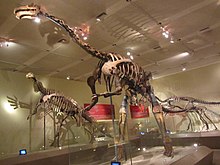Suzhousaurus
| Suzhousaurus Temporal range: Early Cretaceous,
~ | |
|---|---|

| |
| Mounted skeleton displayed in National Museum of Natural Science with elements from both specimens | |
| Scientific classification | |
| Unrecognized taxon (fix): | Suzhousaurus |
| Type species | |
| †Suzhousaurus megatherioides Li et al. 2007
| |
Suzhousaurus is a genus of large therizinosauroid dinosaur from the Early Cretaceous of China. It was an unusually large dinosaur for its time, reaching lengths of 6 meters (20 ft) and weighing nearly 3.1 tons (3,100 kg). It was a herbivore and known from two specimens discovered in the Xiagou Formation and Zhonggou Formation in China.[1][2]
History/Discovery[change | change source]
The genus Suzhousaurus was named after the old name of Jiuquan, the city where it was found. The first specimens were discovered during field works in 1999 and 2004 in the Xiagou Formation and Zhonggou Formation, which are part of the Xinminbao Group in China. It’s considered a significant find due to its large size and because it helps to understand more about therizinosauroid dinosaurs.[3] The name Suzhousaurus is derived from “Suzhou,” which is the old name for the Jiuquan area where the dinosaur fossils were found. The suffix “-saurus” is commonly used in dinosaur names and means “lizard” in Greek, so Suzhousaurus translates to "Suzhou lizard".
Unique features[change | change source]
Suzhousaurus had several unique features that differentiated it from other therizinosaur taxa:
- A round top border of the preacetabular projection of the ilium.
- A foramen (hole) on the obturator area with a total width greater than its height.
- A relatively short pubis with a deep and wide obturator notch.
- The ischiadic shaft was deflected towards the rear.
Additionally, it was an unusually large Early Cretaceous therizinosauroid, reaching lengths of 6 meters (20 ft) and weighing nearly 3.1 tons (3,100 kg). Its upper arm was very distinct from other therizinosaurids, which contributed to its classification as a therizinosauroid.[4] These features reflect its adaptations as a herbivore with a specialized diet.
Habitat and environment[change | change source]
Suzhousaurus lived during the Early Cretaceous period in what is now China. It inhabited areas known as the Xiagou Formation and Zhonggou Formation, which are part of the Xinminbao Group. These formations suggest a habitat that was likely rich in vegetation, supporting its herbivorous diet. The exact nature of its environment, such as climate and specific flora, is not detailed in the search results. However, it’s reasonable to infer that Suzhousaurus lived in an ecosystem that could sustain large herbivorous dinosaurs.
Feeding habits[change | change source]
Suzhousaurus was a herbivore, as indicated by its classification as a therizinosauroid. Therizinosaurs are known for their long necks and small heads with beak-like mouths, which suggest they fed on vegetation. Their large claws may have been used for defense or to help in feeding, possibly pulling down branches to reach leaves or other plant material.[5] [6]
References[change | change source]
- ↑ "Suzhousaurus". Dinopedia. Retrieved 2024-06-19.
- ↑ "Suzhousaurus". dinosaurpictures.org. Retrieved 2024-06-19.
- ↑ "Suzhousaurus and its strange relatives". Science. 2007-10-11. Retrieved 2024-06-19.
- ↑ "Suzhousaurus and its strange relatives". Science. 2007-10-11. Retrieved 2024-06-19.
- ↑ "Suzhousaurus and its strange relatives". Science. 2007-10-11. Retrieved 2024-06-19.
- ↑ October 11, laelaps on; 2007. "Suzhousaurus and its strange relatives | ScienceBlogs". scienceblogs.com. Retrieved 2024-06-19.
{{cite web}}:|last2=has numeric name (help)CS1 maint: numeric names: authors list (link)
